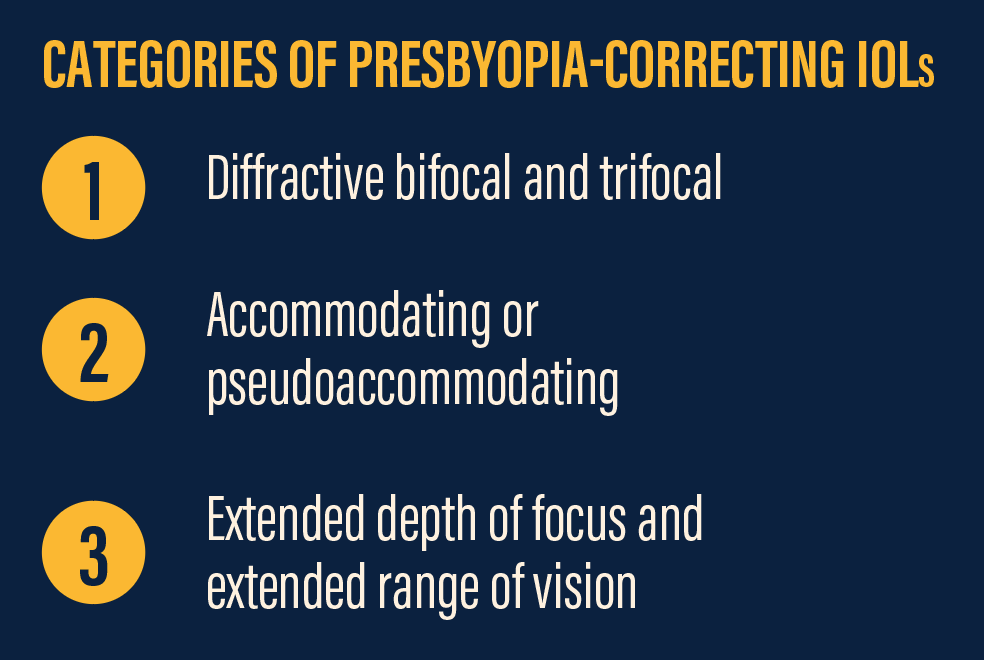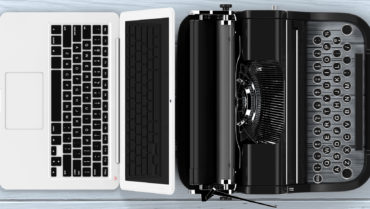Presbyopia-correcting IOLs have changed the game of refractive cataract surgery. This treatment option has grown increasingly popular among patients and physicians due to the number of activities that require near and intermediate vision today. As such, we have seen the emergence of several new technologies in three main categories of IOL platforms: (1) diffractive bifocal and trifocal IOLs, (2) accommodating or pseudoaccommodating IOLs, and (3) extended depth of focus (EDOF) IOLs. This article overviews the differences in these categories and the existing and emerging technologies designed to help us deliver quality vision over a range of distances to our presbyopic patients.

CATEGORIES OF IOLs
Diffractive bifocal and trifocal. Multifocal diffractive and refractive IOL designs aim to focus an image onto more than one focal plane. Although the add powers of diffractive IOLs have decreased over time, a small degree of contrast sensitivity loss still occurs with these lenses as a result of the light split differential inherent to their mechanism of action.
Accommodating. Accommodating IOLs are designed to correct defocus at near and intermediate distances by changing the optical power of the eye, via forward-backward axial movement or flexibility in lens thickness or shape. As suggested by Ong et al,1 these lenses may not provide full accommodation to yield durable gains in near visual function.
EDOF. In 2016, the FDA approved the first IOL for extended range of vision, the »Tecnis Symfony (Johnson & Johnson Vision). The Symfony IOL is designed to create an elongated focus to enhance intermediate and near visual performance. Although the advantages of EDOF and extended range of vision models are promising, it is important to correlate the optical bench performance and clinical performance.2
NOVEL APPROACH TO AN EXISTING IDEA
EDOF IOLs have garnered recent attention; however, the concept of EDOF is not new. More than 3 decades ago, Nakazawa and Ohtsuki3 reported apparent accommodation of approximately 2.00 D in 39 eyes implanted with spherical IOLs. In most circumstances, higher-order aberrations degrade quality of vision. In some instances, however, they may have a beneficial effect. With presbyopia, specific amounts of spherical aberration may expand the depth of focus without significantly compromising quality of vision.4 The introduction of both positive and negative spherical aberration using adaptive optics technology can significantly shift and expand a patient’s overall depth of focus.5
EMERGING TECHNOLOGIES
An enhanced depth of focus can also be achieved with small-aperture, bioanalogic, and echelette technologies, as outlined below.
Small-aperture. The small-aperture design of the »IC-8 IOL (AcuFocus) creates an extended and continuous range of functional vision. This lens features an embedded opaque annular mask that blocks unfocused paracentral light rays while allowing only central paraxial light rays through its aperture. It provides a broad range of functional vision with as much as ±1.00 D of deviation from the targeted manifest refraction spherical equivalent. The IC-8 IOL model may be suitable for post–refractive surgery presbyopes, irregular corneas, and monofocal pseudophakic patients.6
Bioanalogic. The WIOL-CF (Medicem) is a bioanalogic IOL with a unique one-piece polyfocal hyperbolic optic and no haptics. The refractive power is highest in the center and gradually decreases toward the periphery. Observational studies such as that by Studeny et al7 have indicated excellent visual acuity for far and intermediate vision and reasonably good near vision with minimal dysphotic phenomena.
Echelette. The Symfony provides an extended range of vision through the incorporation of a diffractive echelette optical design. Additionally, its achromatic technology corrects for chromatic aberration. These design features improve simulated retinal image quality without compromising depth of field.8,9 As with any multifocal IOL, optimal outcomes with the Symfony require careful patient selection, accurate biometry, astigmatism correction, and IOL centration.
Manifest refraction techniques unique to echelette technology should be utilized to avoid over-minus endpoints. A so-called push plus technique should be performed by determining the highest plus or least minus that produces minimal blur, and the examiner should watch for the refractive plateau. Autorefractors commonly use infrared light with chromatic aberration correction; thus, myopic results can be expected with the echelette’s achromatic technology.
SUMMARY
Presbyopia-correcting IOLs are a valuable treatment option for active patients who seek near and intermediate vision. The development of new lens designs enhances our ability to deliver on their expectations with minimal compromises in visual quality.
In the future, various optical combinations may be possible with EDOF technologies: EDOF optics may be added to accommodating IOLs to provide a synergistic effect for near performance, and additional toric EDOF platforms may be developed to address astigmatism. Regardless, we will surely continue the quest to strike a balance between quality and range of vision—the key to happy presbyopic patients.
1. Ong HS, Evans JR, Allan BD. Accommodative intraocular lens versus standard monofocal intraocular lens implantation in cataract surgery. Cochrane Database Syst Rev. 2014;(5):CD009667.
2. MacRae S, Holladay JT, Glasser A, et al. Special report: American Academy of Ophthalmology task force consensus statement for extended depth of focus intraocular lenses. Ophthalmology. 2017;124(1):139-141.
3. Nakazawa M, Ohtsuki K. Apparent accommodation in pseudophakic eyes after implantation of posterior chamber intraocular lenses: optical analysis. Invest Ophthalmol Vis Sci. 1984;25(12):1458-1460.
4. Rocha KM, Soriano ES, Chamon W, Chalita MR, Nosé W. Spherical aberration and depth of focus in eyes implanted with aspheric and spherical intraocular lenses: a prospective randomized study. Ophthalmology. 2007;114(11):2050-2054.
5. Rocha KM, Vabre L, Chateau N, Krueger RR. Expanding depth of focus by modifying higher-order aberrations induced by an adaptive optics visual simulator. J Cataract Refract Surg. 2009;35(11):1885-1892.
6. Schultz T, Dick HB. Small-aperture intraocular lens implantation in a patient with an irregular cornea. J Refract Surg. 2016;32(10):706-708.
7. Studeny P, Krizova D, Urminsky J. Clinical experience with the WIOL-CF accommodative bioanalogic intraocular lens: Czech national observational registry. Eur J Ophthalmol. 2016;26(3):230-235.
8. Pedrotti E, Bruni E, Bonacci E, Badalamenti R, Mastropasqua R, Marchini G. Comparative analysis of the clinical outcomes with a monofocal and an extended range of vision intraocular lens. J Refract Surg. 2016;32(7):436-442.
9. Cochener B; Concerto Study Group. Clinical outcomes of a new extended range of vision intraocular lens: International Multicenter Concerto Study. J Cataract Refract Surg. 2016;42(9):1268-1275.





